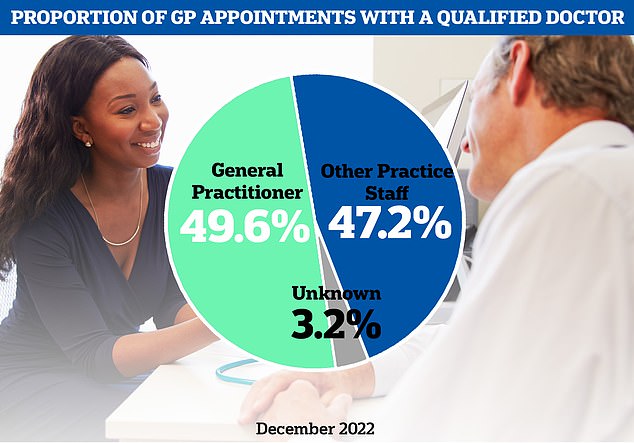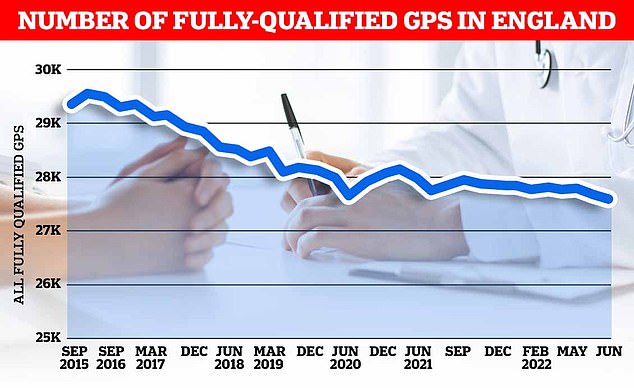How NHS doctor’s £110,000 salary is dwarfed by European counterparts
>
GPs in the UK are infamous for earning eye-wateringly high salaries — skies above what Joe Bloggs takes home in a year.
But global data shows family doctors in elsewhere in the world can rake in even more cash.
Self-employed GPs working in Switzerland just under the equivalent of £220,987 per year.
The figure, from the Organisation for Economic Co-operation and Development is over one-and-a-half times the £133,225 a British GP earns, according to the data.
Germany, Denmark and Luxembourg also paid their family doctors more generously, all having average salaries breaching £15,000.
Organisation for Economic Co-operation and Development (OECD) data (left) shows how self-employed British GP earnings, stack up compared to the rest of the world. NHS data (bottom right) tracks how the average GP salary have grown over time, reaching an average of £111,900 in the 2020/21 financial year. OECD data is based on 2020 data or nearest available year, figures converted into pounds on 7/02/2023

Less than seven in 10 GP appointments in England (68.3 per cent) were held face-to-face in December. It marks the second month in a row that the figure has fallen after peaking at 71.3 per cent in October. Eight in 10 consultations were in-person pre-pandemic. But the figure has so far failed to bounce back
The UK came fifth in the global rankings of self-employed GP earnings, only just beating Ireland (£128,405).
Other data published by the OECD in December showed up GPs in Germany earn 440 per cent more than the average national wage.
By contrast, family doctors in Britain — who earn £112,000, on average in the NHS — are paid 340 per cent more, according to the same report.
The Organisation for Economic Co-operation and Development (OECD) published the data on European GP salaries for 2020 in December.
It split family doctor earnings based on if they were self-employed, such as partners who run a practice, as well as salaried GPs who are employed to work there.
Not all countries had data for both kinds of GPs because of how health systems are set up abroad
Germany and the UK topped the list for self-employed GPs earnings.
They were followed by Austria, Estonia, France and Switzerland, where such doctors get 300 per cent more than the average wage.
Self-employed GPs working in the Netherlands had the lowest comparative wage — only earning 240 per cent of the average national salary.
The latest NHS data shows GP partners in England, who make up roughly two thirds of the entire GP workforce, earned an average salary of £142,000 in 2020/21.
Salaried GPs earn £64,900-a-year on average in England, official statistics show.
The OECD report found salaried GPs earn 180 per cent above the national average wage.
This put the UK in the bottom half of the European pack, scoring the same as Finland.
Spain topped the charts for salaried GP earnings, with doctors there earning 260 per cent of the national average wage.
Portugal came second (240 per cent), followed by Poland (230 per cent).
The figures relate to pre-tax earnings and not take home pay, which can differ due to different levies applied across the continent.
The OECD also measured GP wage growth from 2010-to-2020 in its report.
By this metric, it found GP earnings in England had actually decreased in real terms, due to factors like inflation, by about 0.8 per cent.
In contrast, places like Hungary saw GP wages increase by 4.8 per cent over that same period.
The OECD credited this to efforts by the Government to increase family doctor salaries in order to reduce emigration of its health professionals to other countries offering them more money.
In its report, the OECD acknowledged there were caveats when it came to the GP data and international comparisons.
One of these was that overtime work or bonuses are not included in salary data in some countries, and that GPs can also undertake a mix of private and public work.
The analysis comes amid a huge GP appointment crisis in Britain.
Campaigners claim patients are being trapped in a ‘Catch-22’ system that bounces them between phone queues and online forms as part of the ‘8am scramble’ for appointments.
And when they do eventually get through, many complain they are still unable to secure an appointment in-person.
NHS data for December shows only 68.3 per cent of appointments were held face-to-face that month, down from November’s 69.1 per cent.
This figure is the second consecutive month of declining proportion of in person consultations with GPs in England, haven fallen from 71.3 per cent in October.
While still above the Covid lockdown lows of only 40 per cent of appointments being held face-to-face it is still a far cry from the 80 per cent of consultations held in person pre-pandemic.
Additionally, a recent damning report from the Office of National Statistics (ONS) found one in four are unable to see a GP and one in five waiting for care.
The survey revealed 23 per cent of adults who needed to see a GP last month could not get an appointment.
Some 30 per cent had difficulty contacting their practice while 39 per cent were only offered a telephone consultation.
Only one in three who made an appointment found it ‘easy’ or ‘very easy’ while over half (52 per cent) found it ‘difficult’ or ‘very difficult’.
Others could not see their preferred GP, were offered inconvenient times or told to seek care elsewhere.
And last week GPs threatened to strike over a proposed NHS contract they say fails to pay them enough to see patients.
Exactly why Brits are still struggling to get a GP appointment is complicated.
The problem has been partly caused by hundreds of surgeries shutting over the past decade, forcing millions of patients to switch to a different doctor.
NHS statistics show there were fewer than 6,500 practices open in England this year— down from 8,100 in 2013.
Meanwhile, the same OECD report found the average UK nurse’s annual pay was around £30,880 in 2020.
This is just behind the EU average for the same period (£31,600).
It used data from 20 EU countries and five more from the wider European area, like the UK.

The latest NHS data on GP appointments for December showed the less than half of appointments were with a family doctor

There were just 27,558 full-time equivalent, fully-qualified GPs working in England last month, down 1.6 per cent on the 18,000 recorded in June 2021. It was down 5.3 per cent on the more than 29,000 working in June 2017

This graph shows the average nurses’ pay for a host of European countries as of 2020, taking into account how expensive it is to live in each nation. The UK, at £30,880, comes just under the European average of £31,600 but is almost half the top runner, Luxembourg, which pays an average of £59,790
The OECD calculated the value of the nurses’ wages in terms of how much it costs to live in that nation, a method called purchasing power parity.
This allows a comparison between how much the average nurse’s salary is worth in a country that is more expensive to live with one where it is cheaper.
Luxembourg topped the list for nurses’ pay, with health professionals there earning the equivalent of £59,790.
Belgium came second with £55,700 and the Netherlands third with £45,290.
Britain came in 12th overall, just behind Slovenia where nurses earned the equivalent of £33,330 but ahead of Poland where they earned £30,340.
The OECD also compared how a nurses’ salary stacked up in comparison to the average wage of each nation.
Across the EU, nurses earned 20 per cent more than the average salary in the bloc.
In comparison, UK nurses earned dead-on the average British wage in 2020, similar to nations like Italy and Portugal.
Nurses in Belgium topped the charts earning 60 per cent more than the average wage, followed by Luxembourg and Spain where the health professionals there each earned 50 per cent more than the average worker.
